Reflections: Harrison H. Barrett
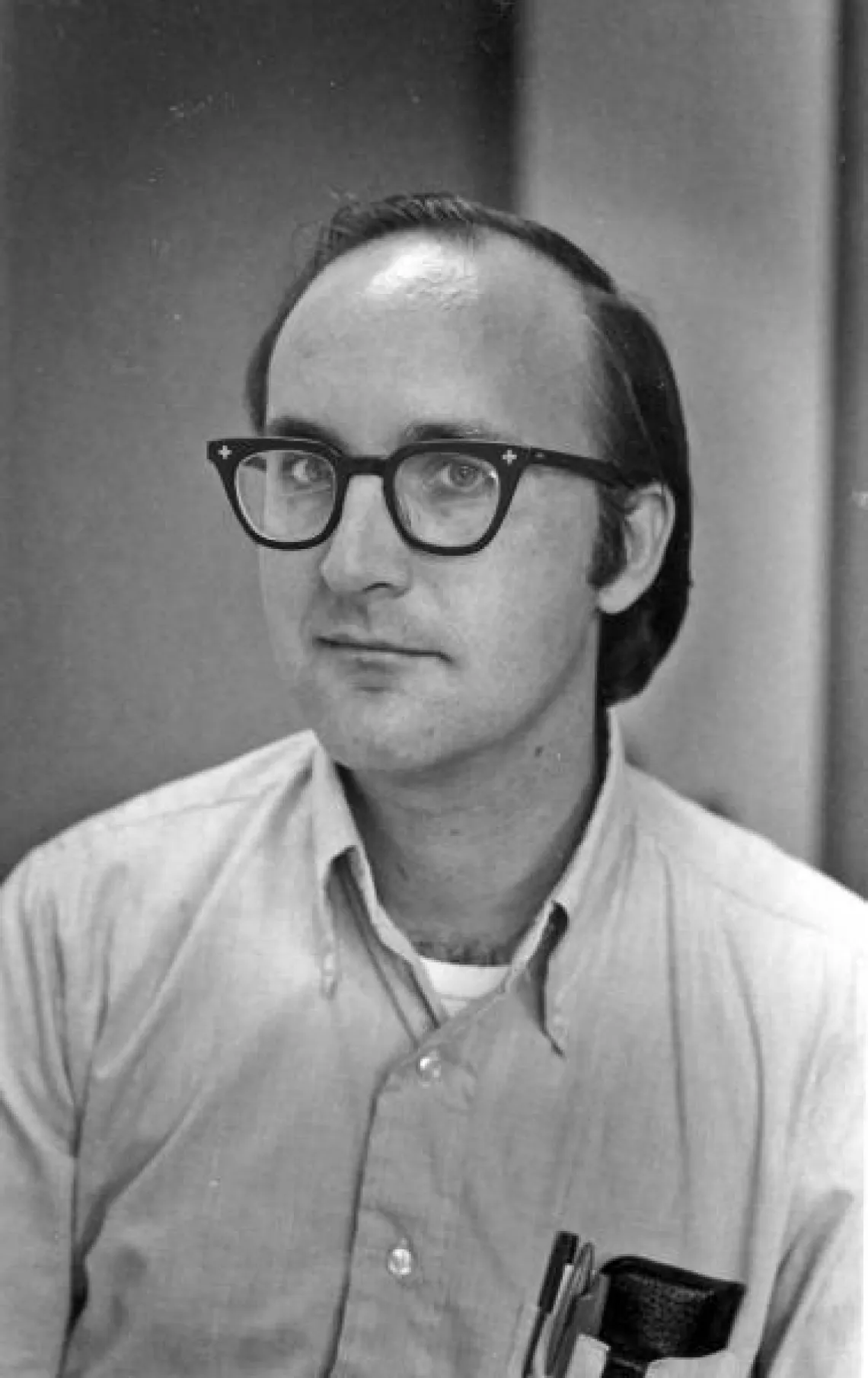
Don’t let your age control your life. Let your life control your age.
Anthony D. Williams
Around the world, a common way to measure a person’s achievements is to correlate them with their age. There seem to be stereotypical age brackets for each of life’s milestones. But, occasionally we come across an individual who defies societal norms, proving that age does not define achievements.
Professor Emeritus Harrison (Harry) H. Barrett made his first gamma-ray image at age 10, when his parents bought him a Gilbert Atomic Energy Lab with real isotopes. And just prior to his 70th birthday, he and his wife, Cathy, trekked the Annapurna Circuit—climbing over the Himalayas, crossing Thorung La pass at 18,000 feet and then plummeting down the other side. Cathy, who has been married to Harry for over 60 years, lovingly—and simply—describes him as someone who “has just always stayed busy doing things.”
Early Life
Born 1 July 1939, to Jacob (Jack) Barrett and Dixie Earnestine Wike, Harry and his siblings Joan and Carl grew up in Norfolk County, Virginia—after his father moved the family from Massachusetts to North Carolina then to Virginia in search of jobs as a printer in the years immediately following the Great Depression. A pioneer in driving instruction, Harry’s mother was the first female driving instructor for AAA in the country. Later, she founded her own company, the Dixie Driving School.
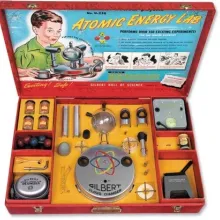
Although neither of Harry’s parents were scientists, they both encouraged his curiosity and interest in science. From an early age, he found great personal pleasure in experimenting and solving problems. On Christmas Day, 1949, 10-year old Harry received a Gilbert Atomic Energy Lab. This high-end science kit included four different types of uranium ore containing isotopes that produced alpha, beta and gamma radiation, an electroscope for detecting charge, a small cloud chamber to watch for particles of ionizing radiation shoot away from your ore, a Geiger counter, and a spinthariscope for watching radiation make phosphor glow. Budding young nuclear scientists were encouraged to use the enclosed instruments to measure the samples’ radioactivity, observe radioactive decay, and even go prospecting for radioactive ores.
I set up a dark room in my family’s bathroom and used towels to keep the light out. After developing a roll of Kodak 620 film with an iron-55 source taped to the outside of the roll, I could see multiple images of the source. They got weaker as the gamma rays went through more layers of the film and more blurred as the layer of the film was farther from the source. At some intuitive level, I understood the concept of exponential attenuation and blur by distance between source and detector.
Harry saw television for the first time in 1951 on a two-week trip to Brooklyn, NY, with his mother and siblings, and absolutely had to understand how it worked. As soon as he returned home, he used money saved from his paper route to enroll in a correspondence course with the National Radio Institute. This course gave him the technical background to pass the exam for an FCC first-class radiotelephone operators license, and to get a job working as a broadcast engineer at WRAP in Norfolk during high school.
Undergraduate Education

Growing up in the post-World War II era influenced Harry greatly. He vividly recalls the crowds celebrating in downtown Murfreesboro, NC, on Victory over Japan (V-J) Day (August 1945). His father lifted six-year old Harry onto the back of a fire truck leading a parade down main street. “The noise was deafening—car horns blaring, sirens going off, plus hundreds of people shouting, hugging and dancing in the streets.” That show of spontaneous patriotism made an impression on Harry he never forgot.
As a senior in high school, Harry wanted to attend West Point to become a Military officer, but his eyesight did not meet the standards. Instead he enrolled at Virginia Polytechnic Institute and State University (VPI) in Blacksburg, VA, which had a large and rigorous Corps of Cadets.
During the summer after his first year at VPI, Harry took a job selling Collier’s Encyclopedias door-to-door. Determined to succeed, Harry read several books on salesmanship, and the techniques he learned helped him become one of Collier’s leading salesmen—selling on an average of three full sets of encyclopedias per week.

2009 Renewing Wedding Vows In Manang, Nepal
Harry now sees that job as having been good training for writing grant proposals. “The same skillset I had to develop as a door-to-door salesman has enabled me to be a successful grant writer, including practical thinking, organization, creativity and persistence.”
When Harry Met Cathy
By the end of Harry’s sophomore year at VPI, he had met Cathy at a teenage dance in Roanoke and, suddenly, the idea of a military career (and the possibility of a remote posting) had less appeal. Harry withdrew from the Corps of Cadets, moved to Roanoke, and took a job with a local company that serviced televisions and two-way radios. During his last two years at VPI, Harry took a full course load, held down a full-time job, and commuted 100 miles a day (roundtrip) to Blacksburg.
Harry and Cathy were married over Christmas break in 1959—honeymooning in New York and Boston, where Harry had arranged job interviews. The interview in New York did not go well, but the one with Raytheon in Boston did, and he pretty much accepted a job offer on the spot. During their time in Boston, they strolled around the campus of the Massachusetts Institute of Technology (MIT).
Very few people were on campus, but I was enthralled to see locked offices of very famous physicists. On a lark, I decided to apply to the Master’s program, even while assuming I had no chance of being accepted. When I received my letter of acceptance, I asked Raytheon if they would employ me only in the summers, and they happily agreed.
Not in Blacksburg Anymore!
After a stimulating and productive summer working in the Instrumentation Group at the Raytheon Research Division, Harry enrolled as a first-year Physics graduate student at MIT. He quickly learned that he “wasn’t in Blacksburg anymore!” He felt every class was over his head, and had to study extra hard to fill in the gaps.
One huge shock was in the second semester when I signed up for a course in mathematical physics taught by a renowned professor, Philip Morse. The class was in a huge auditorium, with maybe 200-300 students. In due course, professor Morse walked onto the stage, held aloft a 1,500-page book, and said, ‘The first 200 pages of this book are trivial. You are responsible for them!’ Ten seconds into the course, and I was already six-weeks behind!
Raytheon
After being awarded a MS degree in Applied Physics in 1962, Harry worked full-time at Raytheon in the Boston area before enrolling in the PhD program at Harvard in 1966. In those four years at Raytheon—under the mentorship of a seasoned researcher named Mel Holland—Harry built lots of instrumentation that he would later use in his PhD dissertation; had articles published in top Physics journals; and became a father. Harry and Cathy’s son, David, was born in October 1962.
Except for the latter point, the culmination of those four years was a paper in Physical Review, the top Physics journal of the day. The paper was Interaction of almost collinear longitudinal phonons, by H. H. Barrett and J. H. Matsinger. John Matsinger was Harry’s technician at the time, and it caused a big stir at Raytheon because technicians were never listed as co-authors.
I was very proud of this paper (still am). It was one of the first papers to show how to do practical calculations with quantum-mechanical coherent states, for which Roy Glauber was later to be awarded the Nobel Prize in Physics. We (meaning John Matsinger) built a sophisticated ultrasound system, and we used it to carry out a wide variety of experiments. In every case, the experimental data was in spot-on agreement with the theory, with no adjustable constants.
I was excited about this work, so I dropped in on senior Raytheon colleague, Sol Aisenberg, to tell him about it. He listened patiently, then when I slowed down a bit, he asked, ‘so, what did you learn?’ I proudly said, ‘I learned that everything was just as I predicted. The theory worked!!’ ‘So,’ said Sol, ‘you didn’t learn anything, did you? You correctly predicted the experimental results.’ We argued a bit, but in mellowed retrospect, I have to agree with him. He summarized the point by saying, ‘If nine out of ten of your experiments don’t fail, you are doing the wrong experiments!’
Over the years, Harry would recount this story to many despondent graduate students to encourage them to do better experiments, as he also insisted their PhD dissertations should have both an experimental and a theoretical component.
Harvard University
While working at Raytheon, Harry set about resolving his academic deficiencies—in hopes of applying to a PhD program. First, he took two courses at Boston University then, at Mel’s urging, he began taking MIT courses one at a time. After accumulating a slew of MIT credits, Harry applied for and obtained a Raytheon fellowship that would pay 80% of his Raytheon salary, plus all books and tuition. His only duty was to earn his PhD, which he chose to pursue at Harvard University.
Armed with this fellowship, I met with Vic Jones, who had been Mel’s advisor. Of course, he readily agreed to accept me (and my fellowship) into his group. I had to take four graduate courses, transfer eight MIT courses, and take an oral exam. All this was completed in my first year at Harvard, whereupon Vic left for a one-year sabbatical in Europe. When he returned, I handed him my dissertation—with all experiments conducted at Raytheon—and my two-year career at Harvard was over.
After receiving his PhD in Applied Physics from Harvard University in 1969, Harry continued working at Raytheon. Personally, the highlight of those years was the adoption of his and Cathy’s daughter, Mindy, in February 1969.
Medical Electronics
Back full-time at Raytheon, Harry served as a “utility player” in their Research Division for a while, dabbling in laser-induced damage, lead selenide IR detectors and ultra-high-Q magnetostrictive resonators, but he yearned for his own long-term project. His chance came in 1970 when Raytheon decided to develop new business areas counter-cyclical to the Department of Defense. They acquired several high-profile companies, including Beechcraft Aviation and Amana Appliances, but also set up a process to stimulate internal innovation—called Delphi, a double-entendre evoking iterative problem solving and the fabled Oracle of Delphi.
A team of a dozen or so young scientists from the Research Division was assembled, and I volunteered to be a part of it. Each of us had to choose a new area not currently represented in Raytheon’s intellectual portfolio then read up on the subject, learn the state of the art, identify unsolved problems, and suggest new approaches which the company might research. I knew immediately which area I would choose. Just six years earlier, my mother had died a horrible death, from widely disseminated cancer, and I wanted desperately to do something about such cases. I called my proposed project ‘Medical Electronics,’ because ‘Medical Imaging’ wasn’t a thing yet.
I traveled to many hospitals in the Boston area and beyond, asked a lot of dumb questions, and pressed many doctors for what they ‘really’ needed. Throughout, I tried to connect things the doctors needed, but didn’t know they needed, to things I knew about. My first paper in this field was entitled, ‘Pulse Compression Methods for Radiology.’ For it, I designed and built a ridiculously large surface-acoustic-wave (SAW) filter—a gadget that I had patented, with others, in my earlier stint at Raytheon. I also started submitting lots of other patents. With this backup, Raytheon eagerly accepted my proposal and set me up with a budget, a lab and a small team. I was off and running!
When Harry Met Peter
In late 1970, Harry attended a seminar given by University of Michigan professor Peter Franken—then, also director of the Advanced Research Projects Agency (ARPA) in Washington, DC. At the time, Peter had an idea for an invention that would “make the lightbulb obsolete,” and he thought Raytheon was just the company to support it.
Peter began his talk by discussing an obscure quantum-mechanical effect called the Schwarz-Hora effect, essentially modulation of an electron beam with a laser. Soon, however, he switched to field emission as in certain kinds of electron microscopy. He considered a needle electrode illuminated by a high-power laser and showed that there was electron bunching as in a klystron, and the resulting oscillating dipole moment produced secondary radiation at twice the laser frequency. Peter then calculated the efficiency of this conversion and found it to be around 10-6. Seemed hopeless, but after a dramatic pause Peter said, ‘Ah, but what happens if you have 106 needles?’ He argued that the input power would scale as N (number of needles), but the emitted power would go as N2 because the emission would be coherent. Thus, said Peter, ‘the efficiency would be near 100%!’ Vigorous discussion ensued, but almost everyone, save one lone dissenter, thought it was a great idea. The dissenter was a Crusty Old Radar Engineer (CORE), who said simply, ‘It’s an end-fire array. It won’t work!’
The outcome of the meeting was the usual corporate response to form a committee. Considering himself “somewhat of a hotshot quantum-mechanic,” Harry volunteered. His task was to rederive Peter’s conclusion from the Schwarz-Hora viewpoint. Getting nowhere, he then remembered CORE’s advice: “It’s an end-fire array. It won’t work!” Harry stopped reading the QM literature and went to the radar literature. Sure enough, CORE was right, and he could explain it without quantum-mechanics.
The committee met and accepted my (CORE’s) conclusion. Then they unanimously nominated me to explain it to Peter. Gulp! I expected this famous, near-Nobel physicist to chew me up and spit me out. Instead, he listened intently, asked all the right questions, and after half an hour agreed with me. The lightbulb would not (yet) become obsolete, and this bizarre sequence of events would, later, have a profound effect on my life.
Harry the Polyglot
As a consummate learner, Harry had always had a fascination with foreign languages, feeling that “speaking additional languages empowered a person to access information that would otherwise be off-limits.”
My father, who grew up in North Carolina, used to say he spoke three languages: ‘hillbilly, profane and some English.’ I have a different categorization, and have formally studied four foreign languages, Latin, French, German and Russian.
In graduate school, Harry was required to demonstrate reading knowledge of two foreign languages, and chose French and German. French was an easy choice—Harry had studied French during his undergraduate years at VPI—but he had never attempted to learn German. Before taking the German exam, he signed up for a prep course, deciding to concentrate on the structure of the language—rather than vocabulary—because he would be allowed the use of a dictionary during the exam. Halfway through that semester, Harry took the German reading exam, passed it, and dropped the prep course—thereby defeating the entire purpose of the exam by not learning a word of German!
Later, still feeling guilty at this lapse, Harry decided the only way to learn a foreign language was to take a “sabbatical” in an appropriate country—even though he was not yet a faculty member of any university.
In 1970, shortly after completing my PhD, I came across a notice that the U. S. National Academy of Sciences was setting up an exchange program with its counterpart in the Soviet Union. The idea intrigued me, so I came home from work one day and asked Cathy if she wanted to move to Moscow. Probably not believing I was serious—or maybe that I didn’t have a chance to get the fellowship—she readily agreed, and our whole family signed up for Russian courses. I completed five semesters of Russian in a calendar year; Cathy spent the year studying conversational Russian; David worked with a tutor and even tiny Mindy learned a few words. And I got the fellowship!
Three days after arriving in Moscow in May 1971, Harry was scheduled to give his first-ever scientific talk in Russian at the Institute of Radio Technology and Electronics, one of the institutes of the Soviet Academy of Sciences. Having prepared diligently for this occasion, including making his slides in Russian and writing out his talk in Cyrillic cursive, Harry stepped confidently to the podium on the appointed day.
With scarcely a glance at my sheaf of notes, I launched into my talk. I explained who I was and why I was there, and got some nervous laughter when I said in Russian that I worked for the military-industrial complex. I seemed to be reaching the audience!
Unfortunately, things changed when I called for the first slide. I discovered that I didn’t have a podium light! I moved over to a window where a sliver of light was coming through and, in the process, I dropped my sheaf of notes. I scooped them up, but then realized I had neglected to number the pages! The notes were useless, but the effort I had put into them was not. By now, the first slide was on the screen, and I launched into the talk. Everything went relatively smoothly for the next 50 minutes or so, but I struggled a bit in the discussion session.
Over their time in Russia, Harry gave the same talk (with notes including page numbers) another half-dozen times, and it got better each time. After the third talk, he didn’t even take the notes with him. Incidentally, ten years later, Harry would correct his German language deficiency by taking his next “real” sabbatical in Bavaria.
When Harry Met Peter, Again
By 1971, Harry was keeping the Raytheon patent attorneys busy and, in early 1972, he was given permission to start publicizing and publishing his ideas. Choosing his venues carefully, he spoke at the first SPIE Medical Imaging Conference and the first Gordon Research Conference on holography. Harry published in medical and engineering journals, and gave a scientific exhibit at the Society of Nuclear Medicine meeting, which won a silver medal—the highest honor ever given in the instrumentation category.
By the end of 1972, I was getting many invitations to speak at conferences and universities. In the summer of 1973, one invitation brought me to Washington, DC for a joint OSA/IEEE meeting on laser applications. During my talk, I had not noticed that Peter Franken was in the audience, but he was, and he invited me to lunch. When we sat down, Peter took off his University of Michigan nametag and, with great fanfare, he replaced it with a nametag from the University of Arizona. This was his way of telling me that he was to become the next director of the Optical Sciences Center (OSC). Peter then proceeded to recruit me.
From Industry to Academia
During the same time period that Peter was recruiting Harry for a position at OSC, professor Paul Capp was simultaneously recruiting him to the University of Arizona’s (UA) Department of Radiology.
Paul was a visionary radiologist and a founder of the UA College of Medicine. His main vision was an all-digital radiology department. To realize this vision, Paul had recruited Sol Nudelman, an accomplished developer of imaging systems, from the University of Rhode Island. As soon as Sol’s new position in Arizona was consummated, he approached me and suggested we apply for a newly announced NSF grant, which had to be a partnership between industry and academia.
I was to present the case for digital computing in nuclear medicine, Sol aspired to develop digital subtraction angiography, and Paul would stress the virtues of digital processing of radiographs in general. After writing and submitting what I thought was a bullet-proof NSF grant, we flew to Washington, DC for a required site visit at NSF’s headquarters. Surprisingly, the reviewers turned out to be quite hostile to our digital approach. One reviewer even wrote that ‘there is no future for computers in radiology.’
Undaunted by the review, Paul continued to propound his vision and Sol doggedly pursued his dream to build the world’s first digital radiography system for digital angiography, just as Paul had envisioned. As for Harry, he accepted an associate professor position (with tenure) in Arizona, joint with OSC and the Department of Radiology. (Harry was promoted to professor in 1976, served as acting director for OSC in 1983, and was honored with a Regents’ Professorship in 1990.)
Have Position, Must Secure Funding
Shortly after arriving in Tucson—in an attempt to erase the memory of the NSF fiasco— Harry applied for his first NIH program project grant, entitled Improved collimators for nuclear medicine. In due course, the grant was renewed at five-year intervals until the mid-1990s. Other funding sources in the 1980s and ‘90s included the Air Force Office of Scientific Research, Sandia National Lab, various industrial sources, and internal funding from the Department of Radiology.
By the 1990s, I could see the benefit of having a grant with several coordinated research projects—especially after I recruited Lars Furenlid, who brought a very high level of expertise in electronics and software into the group.
With this new capability, Harry applied for and received a Biomedical Technology Research Resource (P41) grant. His group continued this P41 for 21 years, until 2020—by which time, around 80 graduate students had received PhD degrees for research performed under this grant.
Foundation of Image Science
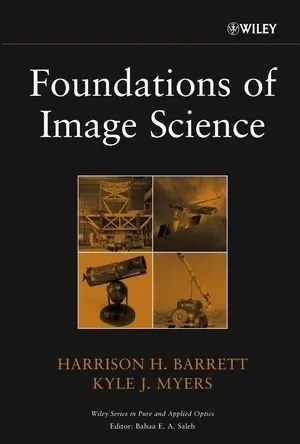
Over his career, Harry has published more than 300 journal papers, has given over 125 invited presentations at scientific conferences, and he holds 29 patents. Probably his most renowned publication is the book, Foundations of Image Science, which he co-wrote with his former student Kyle Myers (PhD 1985). The winner of the SPIE/OSA Joseph W. Goodman Book Writing Award in 2006, the book covers the principles, data and higher mathematics involved in imaging systems, and how to comprehend and evaluate those systems. “The hardest part about writing the book was stopping. At the end of each chapter, we could see many other directions to explore.”
The eight-page epilogue was written to give readers Harry and Kyle’s vision for future research, and to suggest the many paths that might be followed. To illustrate these concepts, a figure showing the “roadmap for the systematic optimization of gamma-ray imaging systems” was included. First presented by Kyle in 1985 at a medical imaging conference at Georgetown University, the roadmap featured a feedback path for the continual optimization of imaging systems. Though published 16 years ago, it would be hard to find any section of the book obsolete or even seriously incomplete to this day.
Greatest Impact on Imaging Science
Harry's impact on imaging science is largely due to his dedication to teaching and his mentoring of graduate students. He brought great enthusiasm to each course, regardless of the number of times he taught the material, and he insisted on generating new teaching notes for each class to keep his presentations fresh. His teaching extended far beyond the classroom, too. His questions at the microphone during a conference were known for being mini-tutorials that brought clarity and depth to the discussion. His many lectures at conferences and institutions around the world built a far-reaching community of imaging science enthusiasts. (Kyle Myers, PhD 1985)
During his years at the University of Arizona, Harry taught more than 20 different courses, and has been the advisor for 64 PhD students and 20 MS students. When students ask him whether they should work in industry, national labs or academia, Harry quickly tells them that it depends upon how they personally measure success—as for himself, he keeps score by the number of dissertations produced in his group, not by money. “It is amazing to see a first-year graduate student, somewhat bewildered, not knowing which end of the soldering iron to hold, emerge five years later an accomplished researcher and ready to become a leader in the field.”
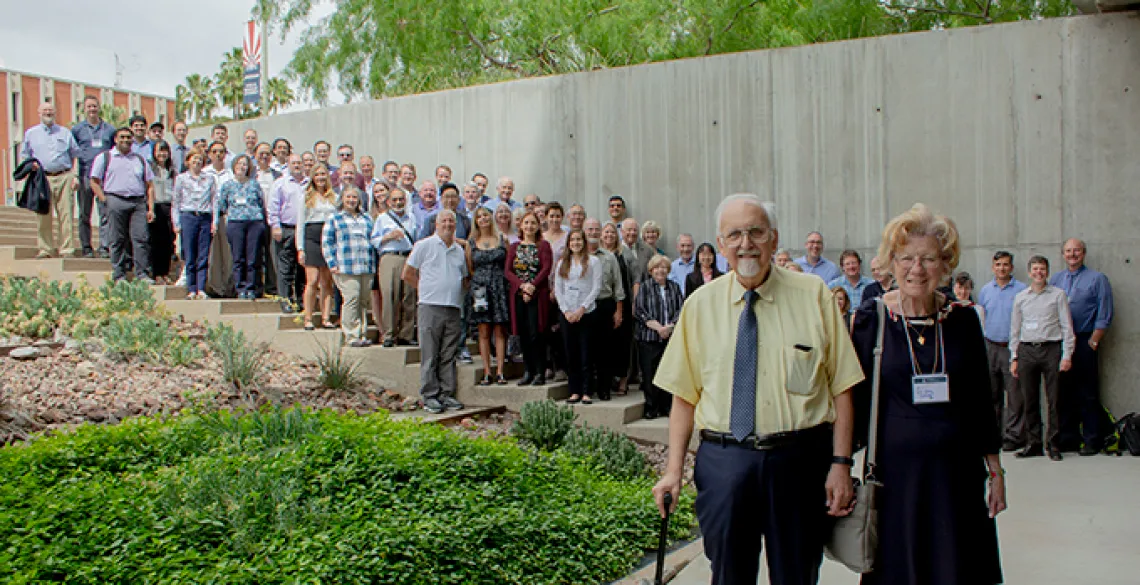
2019 Harry Barrett Retirement Celebration
University of Rochester Professor Jannick Rolland (PhD 1990) came to Arizona from France, and vividly recalls her struggle with command of the English language—and Harry’s willingness to help.
Harry, who spoke several languages, including French, came to my rescue on numerous occasions while working with him. Once in a while I would try to say something in English while translating from French—struggling with pronunciation the most. I recall trying to pronounce the word ‘matrices’—which sounded more like ‘mattresses’ when I said it. It is funny now, but my goodness, it was quite embarrassing then. Harry kindly took me aside and patiently explained these words and their pronunciation. He truly took all of his students ‘under his wing’ in such a way that ensured we could ‘fly high’ in whatever path we chose next.
OSC Professor Arthur (Art) Gmitro (PhD 1982) credits Harry as the reason he pursued a career in Academia. “Harry’s love for his research work and the example he set giving his time and energy to his students are what I appreciated the most, and have tried to emulate in my own career. He set a very high bar for the clarity and rigor of his scientific work that many admire, but few are able to regularly achieve.”
In 2014—for the many ways he has enriched their lives—Harry’s former student’s and colleagues honored him by setting up the Harrison H. Barrett Graduate Student Scholarship in Optical Sciences and Medical Imaging. This scholarship is open to first-year PhD students whose research interest is the application of optical technologies in areas of medical imaging.
Life Beyond Image Science
After contributing for more than 45 years to the understanding of the physics, mathematics and engineering of medical imaging and image science—with joint appointments in the College of Optical Sciences, the College of Medicine, Applied Mathematics, Biomedical Engineering and the Arizona Cancer Center—it is no wonder that Harry would also have an eclectic mix of outside interests, including adventure travel, trekking, foreign languages, history, horseless carriages and baseball trivia.
Harry and Cathy had camped and hiked with their children for many years, but 20 years ago they took it up a notch by trekking into the Mt. Everest base camp. With two weeks of walking and 25,000 feet of total vertical ascent, they reached the summit of Kala Pattar, from which they could see the tents of the base camp far below them. They were hooked—and almost every year since then have trekked and climbed.
The year 2009 was particularly special. Cathy and I trekked the Annapuma Circuit, literally climbing over the Himalayas, crossing Thorung La pass at 18,000 feet and then plummeting down the other side. Along the way, we stopped in the village of Manang at 13,000 feet and renewed our wedding vows for our 50th wedding anniversary.
On that same trip, our porters carried an ‘x-ray suitcase’ designed and built by my students. It included an inexpensive digital x-ray detector based on a Nikon DSLR camera; we used the same camera to photograph the magnificent Annapurna range and to acquire digital x-ray images in remote Himalayan clinics.
Just shy of his 80th birthday, Harry retired from the University of Arizona in May 2019. True to form—at a celebration of his remarkable career—Harry announced he would be co-teaching a new course entitled Image Science for Oncology, and would still be available to consult with any of his “academic children.”
Professional Societies and Honors
Considered an icon in the theory and application of image science, Harry has received many accolades and honors from the scientific community, including the Humboldt Prize (1980); the IEEE Medical Imaging Scientist Award (2000); the C. E. K. Mees Medal, OSA (2005); the J. W. Goodman Book Writing Award, with K. J. Myers, SPIE/OSA (2006); the Founders Day Faculty Science Award, UA College of Medicine (2006); the M. Paul Capp Award, UA Dept. of Radiology (2010); the IEEE Medal for Innovations in Healthcare Technology (2011); and the Gold Medal of the Society, SPIE (2011).
Harry is a Fellow in the American Institute of Medical and Biological Engineering (AIMBE), the American Physical Society (APS), the Institute of Electrical and Electronic Engineers (IEEE), the International Society for Optics and Photonics (SPIE) and the Optical Society (OSA). He served as the editor of the Journal of the Optical Society of America (JOSA) from 1985 to 1991.
In 2014, Harry was elected to the National Academy of Engineering (NAE) and, in 2018, he was named as a Fellow of the National Academy of Inventors (NAI). In 2018, SPIE voted to establish the Harrison H. Barrett Award in Medical Imaging, to be presented in recognition of outstanding accomplishments in medical imaging. The inaugural award was presented to Harry, along with Arthur Burgess, Chares Metz and Robert Wagner in Feb. 2019.
Legacy
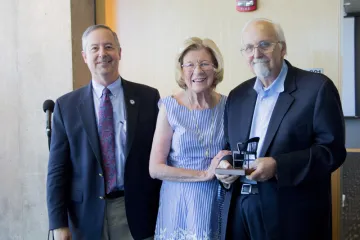
In 2018, Cathy and Harry established the Harrison H. and Catherine C. Barrett Endowed Chair in Optical Sciences and Cancer Imaging to support a faculty position in OSC, with a membership in the University of Arizona Cancer Center (UACC). “This endowment will provide a critical competitive edge to attract remarkable talent like Harry to the University of Arizona, and to support them in their groundbreaking research programs,” said Tom Koch, dean of OSC.
